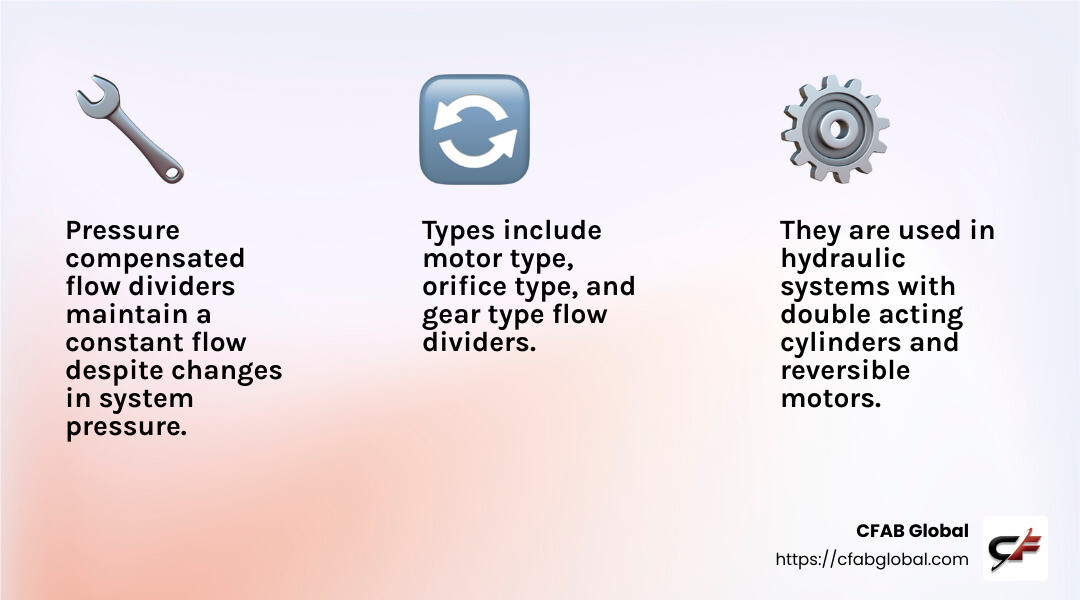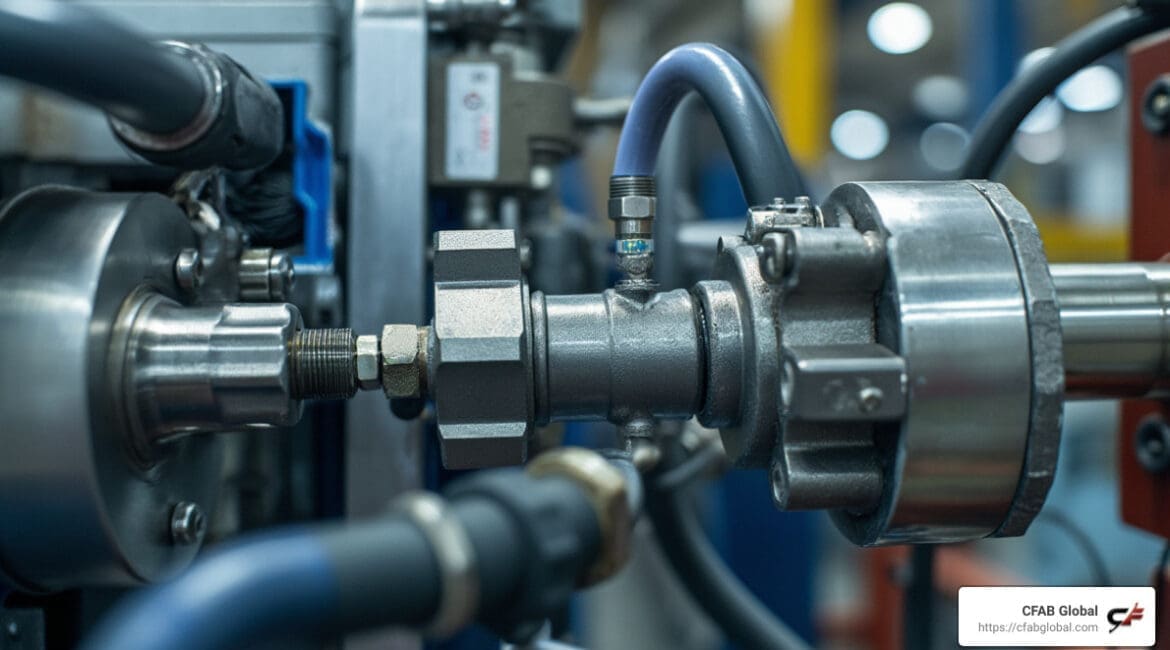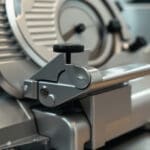If you’re looking for a quick understanding of what a pressure compensated flow divider is, here it is:
- A pressure compensated flow divider is a device used in hydraulic systems to ensure equal flow division between motors or cylinders, regardless of variations in pressure.
- It works by automatically adjusting the flow based on pressure changes, maintaining accuracy and efficiency.
- This technology is crucial in applications where synchronized movements are necessary, such as in double acting cylinders or reversible motors.
In hydraulic systems, finding a way to balance efficiency, accuracy, and reliability can be a challenge. A pressure compensated flow divider is like the unsung hero in this scenario. It ensures that hydraulic motors and cylinders receive nearly equal flow, regardless of pressure differences. This is vital in applications such as construction machinery, industrial equipment, and even in agriculture, where maintaining synchronized movements can make all the difference.
At CFAB Global, we understand the intricacies involved in optimizing machinery operations. The integration of a pressure compensated flow divider can transform your system’s performance by minimizing differences that lead to lag and inefficiencies. I’m Todd Cleppe, leading CFAB Global with over 25 years of experience in manufacturing process improvements and automated systems. Our pressure compensated flow divider solutions are specifically designed to meet the unique challenges faced by industries that rely on heavy machinery.

Easy pressure compensated flow divider word list:
- adjustable flow divider
- how does a hydraulic flow divider valve work
- hydraulic priority flow divider
What is a Pressure Compensated Flow Divider?
A pressure compensated flow divider is an essential component in hydraulic systems. Its primary function is to divide a single flow of fluid into two or more equal parts, regardless of any differences in pressure. This ensures constant flow to each outlet, which is crucial for maintaining synchronized movements in machinery.
How does it work?
The flow divider adjusts automatically to pressure changes, ensuring that each outlet receives the correct amount of fluid. This is achieved through a mechanism that includes a compensator spool and pilot lines, as illustrated in various hydraulic circuit designs. By maintaining a constant pressure drop across orifices, the flow divider guarantees that fluctuations in pressure don’t affect the flow rate.
Why is it important?
In applications like double acting cylinders and reversible motors, consistency in flow is crucial. Imagine a construction crane lifting a heavy load; if one cylinder receives more fluid than another, it could lead to uneven lifting, risking safety and efficiency. A pressure compensated flow divider prevents such imbalances, ensuring smooth and coordinated operation.
For industries that depend on precise and reliable hydraulic systems, integrating a pressure compensated flow divider can significantly improve performance. At CFAB Global, we specialize in providing solutions that address these complex needs, ensuring that your machinery operates at peak efficiency.
Types of Flow Dividers
Flow dividers are essential components in hydraulic systems, ensuring consistent fluid distribution even under varying pressures. Let’s explore the three main types: motor type, orifice type, and gear type.
Motor Type Flow Dividers
Motor type flow dividers consist of two or more hydraulic motors housed together. They share a common shaft, ensuring that all motors rotate at the same speed. This design allows the inlet flow to be split equally among the outlets. Motor type dividers are ideal for applications requiring precise synchronization, such as in hydraulic motor systems. However, if one motor stalls, all motors stop due to the shared shaft, which can be a limitation in some scenarios.

Orifice Type Flow Dividers
Orifice type flow dividers use fixed or variable orifices to control the flow of fluid. These are often non-compensated, meaning the flow rate can change with pressure fluctuations. This type is simple and cost-effective, suitable for applications where precision is not critical. However, they are less accurate compared to other types and can be affected by changes in fluid viscosity.
Gear Type Flow Dividers
Gear type flow dividers are similar to motor types but use gears to split the flow. These are highly precise, offering nearly equal flow distribution. Gear type dividers are often used when accuracy is paramount, such as in synchronized cylinder movements. They are also known for their reliability and efficiency, though they can be more expensive than other types.
In conclusion, choosing the right type of flow divider depends on the specific needs of your hydraulic system. For instance, if you need high precision and reliability, a gear type flow divider is the way to go. For simple applications, an orifice type might suffice. Understanding these types helps in making informed decisions to optimize your system’s performance.
How Pressure Compensated Flow Dividers Work
Pressure compensated flow dividers are essential components in hydraulic systems, ensuring that fluid flow remains consistent even when pressures change. Here’s a closer look at how they work, focusing on the spool-type design, inlet flow, and return flow.
Spool-Type Design
The spool-type flow divider is a common design that uses a spool mechanism to maintain balance between different fluid paths. In this type, the spool automatically adjusts to changes in pressure, helping to keep the flow rate steady. When fluid enters the system, it passes through inlet orifices, causing the spool to move. This movement helps manage how the fluid splits and where it goes.
Inlet Flow
When fluid enters the inlet-return port, it goes through the inlet orifices and splits into two equal parts. This splitting is crucial for ensuring that each hydraulic actuator receives the right amount of fluid. The pressure drop across these orifices causes the spool to separate, which helps control the flow to the outlet-return ports. By doing so, the system ensures that each part of the machinery operates smoothly, even if there are pressure differences at the outlets.
Return Flow
When the actuator reverses, the flow changes direction. The fluid now enters the outlet-return ports, moving through the outlet orifices and back through the inlet orifices. This reverse flow causes the spool sections to come together, adjusting the flow path once more. The outlet orifices then control the return flow, ensuring that no actuator runs too fast or ahead of the others. This balance is vital for maintaining consistent and reliable operation of hydraulic systems.
Overall, the spool-type flow divider is a remarkable tool for managing fluid dynamics in complex hydraulic systems. Its ability to adjust automatically to pressure variations makes it a reliable choice for many industrial applications.
Benefits of Using Pressure Compensated Flow Dividers
Pressure compensated flow dividers are vital in making hydraulic systems more precise and efficient. Let’s explore some of the key benefits they bring to the table, focusing on accuracy, efficiency, and reliability.
Accuracy
One of the standout features of pressure compensated flow dividers is their ability to maintain almost equal flow rates, even when there are pressure differences in the system. These dividers can achieve approximately 90-95% accuracy. This precision is crucial for applications like double acting cylinders and reversible motors, where synchronized movements are necessary. By ensuring that each actuator receives nearly the same amount of fluid, pressure compensated flow dividers help prevent lag and misalignment, which can cause operational issues.
Efficiency
Efficiency is another significant advantage of using these flow dividers. By managing the flow of hydraulic fluid more precisely, they reduce the energy wasted in the system. For instance, in a bleed-off circuit, a pressure-compensated flow control valve ensures that excess fluid is directed to the tank at a controlled rate, minimizing energy loss. This approach contrasts with non-compensated systems, where excess flow often results in higher energy consumption due to pressure fluctuations.
Reliability
Reliability is at the heart of why industries choose pressure compensated flow dividers. These devices automatically adjust to pressure changes, ensuring consistent operation. This automatic adjustment minimizes the risk of equipment failure due to uneven fluid distribution. By maintaining a consistent flow, these dividers prolong the lifespan of hydraulic components and reduce maintenance needs. This reliability is especially important in industries where downtime can be costly.
In summary, pressure compensated flow dividers offer a blend of accuracy, efficiency, and reliability that makes them indispensable in many hydraulic applications. Their ability to maintain consistent flow under varying pressures ensures smooth operations, making them a preferred choice for engineers and technicians alike.
Applications of Pressure Compensated Flow Dividers
Pressure compensated flow dividers find their place in various hydraulic applications, offering precise control and synchronization. Let’s explore some common uses, focusing on hydraulic systems, double acting cylinders, and reversible motors.
Hydraulic Systems
In hydraulic systems, maintaining a balanced flow is crucial. Pressure compensated flow dividers excel in this area by ensuring that hydraulic fluid is distributed evenly, even when pressure differences arise. This balance is vital for the smooth operation of complex machinery where multiple actuators need to work in harmony. By keeping the flow consistent, these dividers help prevent issues like uneven wear and tear, ultimately extending the life of the system.
Double Acting Cylinders
Double acting cylinders require precise flow control to function correctly. These cylinders move back and forth, and any imbalance in flow can lead to synchronization problems. Pressure compensated flow dividers ensure each side of the cylinder receives an equal amount of fluid, preventing misalignment and potential damage. This precision is particularly important in applications like construction equipment and manufacturing machinery, where accuracy and reliability are paramount.
Reversible Motors
Reversible motors, which can change direction, also benefit significantly from pressure compensated flow dividers. These motors need a steady flow of hydraulic fluid to switch directions smoothly. Without a consistent flow, motors might experience jerky movements or stalls, leading to inefficiencies and potential breakdowns. By maintaining a balanced flow, these dividers ensure that reversible motors operate seamlessly, enhancing performance and reducing maintenance needs.
Pressure compensated flow dividers are indispensable in applications where precision and reliability are critical. They provide the necessary balance and control, ensuring that hydraulic systems, double acting cylinders, and reversible motors perform at their best. This makes them a go-to solution for engineers aiming to optimize the performance of hydraulic machinery.
Frequently Asked Questions about Pressure Compensated Flow Dividers
What is the main purpose of a pressure compensated flow control valve?
A pressure compensated flow control valve is designed to maintain a constant volume flow rate despite fluctuations in system pressure. This is crucial in hydraulic systems where consistent flow is necessary for the smooth operation of machinery. The valve adjusts to changes in pressure, ensuring that the flow remains steady. This feature is particularly beneficial in applications where precise control is required, such as in double acting cylinders and reversible motors.
What is the pressure drop in the flow divider?
Pressure drop refers to the reduction in pressure as fluid moves through a flow divider. In a pressure compensated flow divider, the pressure drop is managed to ensure that the flow remains constant, even if there are variations in system pressure. This is achieved by adjusting the internal components of the flow divider to compensate for any pressure loss. While some pressure drop is inevitable, the design of pressure compensated flow dividers helps minimize its impact, ensuring efficient operation of hydraulic systems.
What are the different types of flow dividers?
Flow dividers come in several types, each suited for different applications:
-
Motor Type: These use hydraulic motors to split the flow. They are ideal for applications requiring synchronization, such as when using multiple actuators. However, they may not be as precise as other types due to potential pressure differences at the outlets.
-
Orifice Type: These rely on orifices to divide the flow. They are simple and effective for applications where precise flow division is not critical. They work well in systems where the pressure is relatively constant.
Each type has its advantages and is chosen based on the specific needs of the hydraulic system. For example, motor types are often used when synchronization is crucial, while orifice types might be preferred for simpler applications.
In summary, understanding the purpose, pressure drop, and different types of flow dividers is essential for selecting the right component for your hydraulic system. By ensuring consistent flow and managing pressure effectively, pressure compensated flow dividers improve the performance and reliability of various hydraulic applications.
Conclusion
At CFAB Global, we understand the critical role that pressure compensated flow dividers play in enhancing the performance and reliability of hydraulic systems across various industries. Our expertise in providing advanced machinery solutions ensures that your operations remain efficient and productive.
Our signature Machine Reliability Program is designed to optimize the performance of your machinery. This program offers a comprehensive approach, focusing on predictive maintenance and custom solutions to extend the lifespan of your equipment. By using our proven strategies, you can minimize downtime and maximize output, ensuring a better return on investment.
Industries like manufacturing, construction, agriculture, and energy rely on our solutions to keep their machinery running smoothly. Whether it’s maintaining synchronized hydraulic systems or ensuring precise control in complex applications, our team is here to support your needs.
For those in the food packaging and processing sectors, our partner BE Machinery offers state-of-the-art solutions. From Automatic CIP Cleaning Systems to Hygiene Rotary Fillers, their equipment meets the highest standards of efficiency and hygiene.
For lubrication and fluid handling needs, Graco Inc. provides reliable solutions like automated lubrication systems and bulk fluid handling equipment, ensuring your machinery operates at peak efficiency.
In every engagement, CFAB Global is committed to your success. Our customized solutions and expert support help you overcome challenges and achieve your operational goals. Trust us as your partner in boosting productivity and efficiency.
Explore our services to see how we can support your business with top-tier machinery solutions.






